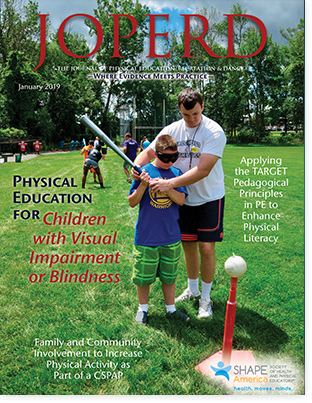 JOPERD Table of Contents
JOPERD Table of Contents
Physical Education for Children with Visual Impairment or Blindness
Lauren Lieberman, Monica Lepore, Maria Lepore-Stevens, and Lindsay Ball

There are over 61,000 school-age children with visual impairments in public schools today. Research has shown that they are often behind their peers in physical activity participation (Augestad & Jiang, 2015; Haegele & Porretta, 2015; Lieberman, Byrne, Mattern, Watt, & Fernandez-Vivo, 2010) and in motor skills (Brian, Haegel, & Bostick, 2016; Haegele, Brian, & Goodway, 2015; Haibach, Wagner, & Lieberman, 2014; Wagner, Haibach, & Lieberman, 2013). In order for children with visual impairments to become physically active and self-determined adults, they must be provided the same opportunities as their same-age peers with the support necessary to ensure full access to the physical education curriculum (Haegele, Zhu, & Davis, 2017; Lieberman, Ponchillia, & Ponchillia, 2013).
Recent research has shown that physical educators perceive children with visual impairments to be one of the most difficult populations to include in general physical education (Lirgg, Gorman, Merrie, & Shewmake, 2017). In addition, these students experience numerous barriers to physical activity in recreation and personal fitness programs outside of the school setting (Perkins, Columna, Lieberman, & Bailey, 2013). The fact is that children with a visual impairments have the potential to perform equally as well or better than their same-age peers when provided with equal opportunity and encouragement. In the 2016 Paralympics in Rio de Janeiro, Brazil, four runners with visual impairments ran the 1,500 faster than the Olympic runners. This is only possible if educators create an environment of opportunity and high expectations.
Since physical educators often report challenges in this area, the purpose of this article is to provide some basic strategies for the inclusion of children with visual impairments in general physical education so that they can meet the national and state standards for physical education and make progress toward full participation and self-determination in society.
To read the rest of this article, click here to download a pdf.